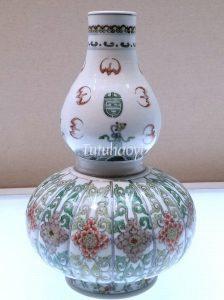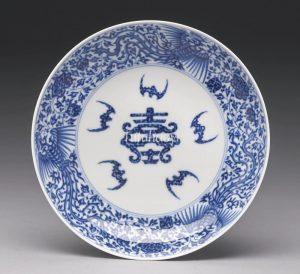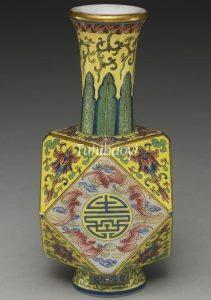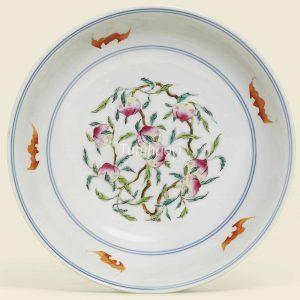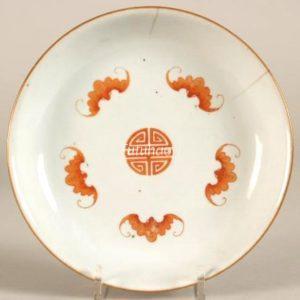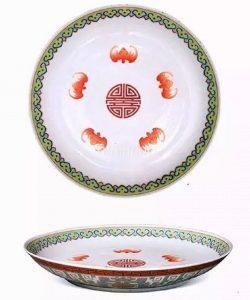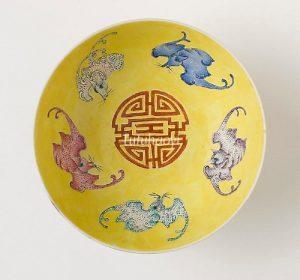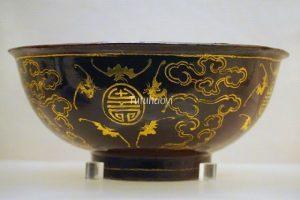May five blessings come your way on your birthday
五福捧寿
© Tutuhaoyi.com owns the copyright of the description content for the images attached. Quoting all or part of the description content on this page is permitted ONLY IF ‘Tutuhaoyi.com’ is clearly acknowledged anywhere your quote is produced unless stated otherwise. (本页描述内容版权归Tutuhaoyi.com所有,转发或引用需注明 “Tutuhaoyi.com”, 侵权必究, 已注开源信息的条目除外。)
Pun Design:
Five + Bat + auspicious character of ‘Longevity 寿 or 壽’
Punning Details:
– ‘蝠 fu’, the Chinese name for bats, puns on ‘福 fu’, meaning ‘good fortune’.
– ‘wu fu 五蝠 five bats’, is homophonous with ‘wu fu 五福 five blessings’. More than two millennia ago, the Chinese had their ideals in life summarised as ‘五福 wu fu’, the Five Blessings, and recorded them in the Book of Documents (书经 Shujing) in the Zhou Dynasty (c. 1046 – 256 BCE). They are ‘longevity 寿 shou’, ‘wealth 富 fu’, ‘wellbeing and peace 康宁 kang ning’, ‘love of virtue 攸好德 you hao de’, and ‘natural death 考终命 kao zhong ming’.
– The motif combination of five bats surrounding a Chinese character 壽, meaning ‘longevity’, in the centre expresses an auspicious wish on one’s birthday.
– Sometimes the image of peaches is used instead of the character ‘寿 or 壽 longevity’. Peach has a nickname ‘shou tao 寿桃 longevity peaches’, which, in Chinese culture, is symbolic for ‘long life’ or ‘shou 寿 longevity’.
Fig 1: doucai gourd-shaped vase, Yongzheng period (1723–35), Qing dynasty, courtesy of the National Museum of China, Beijing
Fig 2: porcelain dish with underglaze blue decoration, Yongzheng period (1723–35), Qing dynasty, courtesy of the Sotheby’s Auction House, New York, 19 March 2014, Lot 466
Fig 3: glass bottle with enamelled decoration, Qianlong period (1736–95), Qing dynasty, courtesy of the National Palace Museum, Taipei
Fig 4: porcelain dish, Qianlong period (1736–95), Qing dynasty, courtesy of Nanjing Museum, China
Fig 5: famille rose porcelain dish, Qianlong period (1736–95), Qing dynasty, courtesy of the Christie’s Auction House, London, 11 May 2015, Lot 31
Fig 6: porcelain dish with overglaze enamelled decoration, Jiaqing period (1796–1820), Qing dynasty, courtesy of Princessehof Ceramics Museum, Leeuwarden, The Netherlands, Object number: NO 05399
Fig 7: porcelain dish with overglaze enamel decoration, Daoguang period (1821–50), Qing dynasty, courtesy of the Palace Museum, Beijing
Fig 8: porcelain bowl with overglaze enamel decoration, Guangxu period (1875–1908), Qing dynasty, courtesy of the Art Gallery of NSW, Sydney, Australia
Fig 9: gilded lacquer bowl, Qing dynasty (1644–1911), courtesy of Sichuan Museum, China
